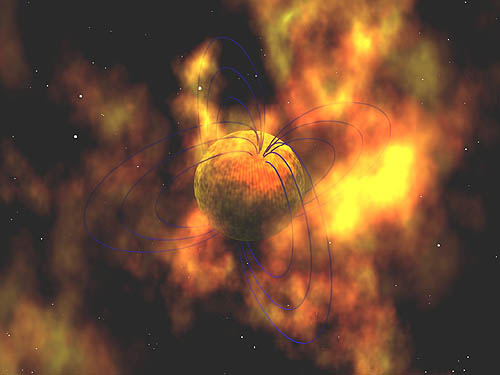
Magnetars, as pictured above in the artist's conception by Robert Mallozzi (UAH/MSFC), are thought to be extremely energetic isolated pulsars with ultra-high magnetic field strengthes (B~10^14 G), and are powered by the decay of their strong magnetic fields. The magnetar model had significant consequences for two classes of neutron star that were previously thought to be unrelated: anomalous X-ray pulsars (AXPs) and soft gamma repeaters (SGRs) are now both considered observable examples of magnetars. The model was introduced by Robert Duncan and Christopher Thompson. Magnetars are the focus of research by McGill Pulsar Group members Fotis Gavriil, Victoria Kaspi, and Cindy Tam, and former member Maxim Lyutikov.
- A Burst and Simultaneous Short-Term Pulsed Flux Enhancement from the Magnetar Candidate 1E 1048.1-5937. Fotis P. Gavriil, Victoria M. Kaspi & Peter M. Woods 2006, ApJ, 641, 418
- Correlated Infrared and X-Ray Flux Changes Following the 2002 June Outburst of the Anomalous X-Ray Pulsar 1E 2259+586. C. R. Tam, V. M. Kaspi, M. H. van Kerkwijk & M. Durant 2004, ApJ, 617, L53
- Anomalous X-Ray Pulsar 1E 1048.1-5937: Pulsed Flux Flares and Large Torque Variations. F. P. Gavriil & V. M. Kaspi 2004, ApJ, 609, L67
- A Comprehensive Study of the X-Ray Bursts from the Magnetar Candidate 1E 2259+586. F. P. Gavriil, V. M. Kaspi & P. M. Woods 2004, ApJ, 607, 959
- A Major Soft Gamma Repeater-like Outburst and Rotation Glitch in the No-longer-so-anomalous X-Ray Pulsar 1E 2259+586. V. M. Kaspi, F. P. Gavriil, P. M. Woods, J. B. Jensen, M. S. E. Roberts & D. Chakrabarty 2003, ApJ, 588, L93
- Explosive reconnection in magnetars. M. Lyutikov 2003, MNRAS, 346, 540
- Magnetar-like X-ray bursts from an anomalous X-ray pulsar. F. P. Gavriil, V. M. Kaspi & P. M. Woods 2002, Nature, 419, 142
What differentiates magnetars from ordinary radio pulsars? This question is currently under consideration by Marjorie Gonzalez and Victoria Kaspi, who study high magnetic field radio pulsars observed at X-ray wavelengthes. These extreme pulsars are not magnetars: they are powered by rotational spin-down, as oppposed to magnetic field decay. However, a growing class of rotation-powered pulsars exhibit magnetar-like properties, such as high B-fields and slow rotation periods. What, then, is the nature of the relationship between these high-B pulsars and magnetars?
- A Braking Index for the Young, High Magnetic Field, Rotation-Powered Pulsar in Kesteven 75. Margaret A. Livingstone, Victoria M. Kaspi, E. V. Gotthelf & L. Kuiper 2006, ApJ, 647, 1286
- Unusual Pulsed X-Ray Emission from the Young, High Magnetic Field Pulsar PSR J1119-6127. M. E. Gonzalez, V. M. Kaspi, F. Camilo, B. M. Gaensler & M. J. Pivovaroff 2005, ApJ, 630, 489
- Spatially Resolved Spectroscopy of the Chandra Field Containing the Supernova Remnant G292.2-0.5. M. E. Gonzalez & S. Safi-Harb 2005, ApJ, 619, 856
- Chandra X-Ray Detection of the High Magnetic Field Radio Pulsar PSR J1718-3718. V. M. Kaspi & M. A. McLaughlin 2005, ApJ, 618, L41
- An XMM-Newton Observation of the High Magnetic Field Radio Pulsar PSR B0154+61. M. E. Gonzalez, V. M. Kaspi, A. G. Lyne & M. J. Pivovaroff 2004, ApJ, 610, L37